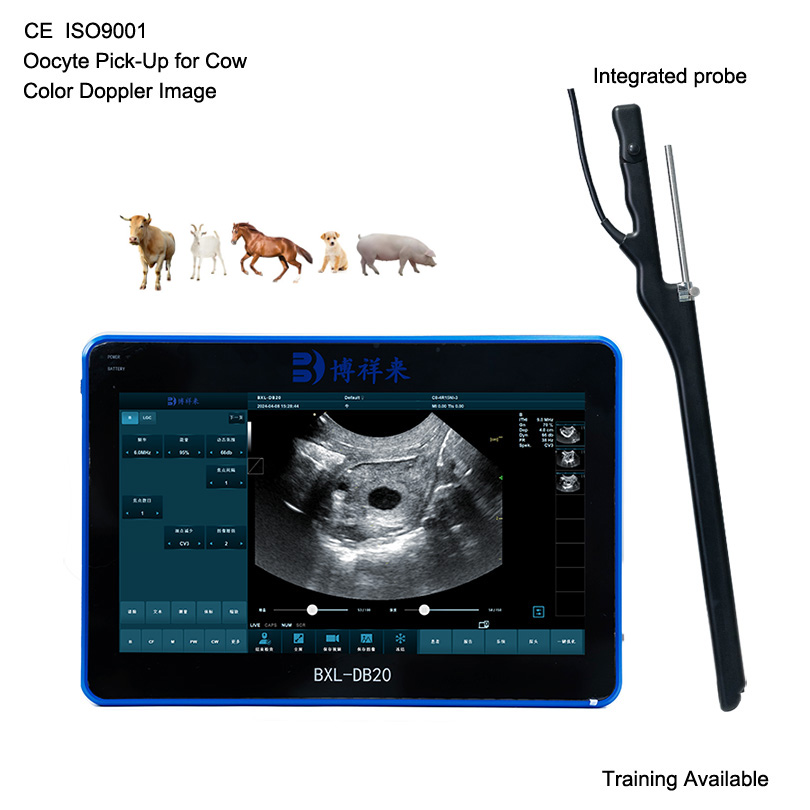Bovine Ovum Pick-Up (OPU) Equipment: Essential Technology for Modern Cattle Reproduction
As the global cattle breeding industry advances, Bovine Ovum Pick-Up (OPU) equipment has become an indispensable tool in improving reproductive efficiency and accelerating genetic progress. Through precise imaging and aspiration systems, OPU technology allows veterinarians to collect oocytes (egg cells) safely from live cows — forming the foundation of modern in-vitro fertilization (IVF) programs in cattle.

What Is Bovine Ovum Pick-Up (OPU)?
Ovum Pick-Up (OPU) is a technique used to collect oocytes from the ovaries of donor cows through transvaginal ultrasound guidance. These oocytes are then fertilized in the laboratory and developed into embryos for transfer into recipient cows.
The process requires professional Bovine OPU equipment, which typically includes:
A high-resolution veterinary ultrasound system for real-time ovarian imaging.
A needle guide and aspiration system for precise oocyte retrieval.
A portable, durable control unit suitable for farm or field use.
This advanced combination of imaging and collection technology ensures efficiency, safety, and high-quality results in bovine IVF procedures.
Key Features of High-Quality Bovine OPU Equipment
When choosing Bovine Ovum Pick-Up equipment, certain technical features can make a major difference in performance and results:
Clear ultrasound imaging for accurate visualization of follicles and oocytes.
Adjustable aspiration pressure for gentle and efficient oocyte recovery.
Lightweight, waterproof design for on-farm use in diverse conditions.
Compatibility with standard OPU needles and collection tubes.
Data recording and image storage to support research and traceability.
A well-designed OPU system not only improves oocyte yield but also enhances animal welfare and procedural accuracy.
Benefits of Using Bovine OPU Equipment in Reproduction Programs
Implementing OPU technology in cattle breeding offers significant biological and economic benefits:
Increased embryo production – allowing more offspring from elite donor cows.
Shorter breeding cycles – with oocytes collected every 10–14 days.
Reduced hormone dependency – minimizing animal stress and cost.
Higher genetic gain – improving herd quality over time.
By integrating a reliable OPU system, farms and IVF centers can achieve higher conception rates and faster herd improvement, making it a valuable investment for both dairy and beef industries.
Applications in Global Cattle IVF and Embryo Transfer
The Bovine OPU process plays a critical role in in-vitro embryo production (IVP) and embryo transfer (ET) programs worldwide. From research institutions to commercial breeding farms, this technology enables large-scale, consistent, and cost-effective reproduction.
In combination with advanced veterinary ultrasound and embryo grading tools, OPU equipment supports international breeding programs in Asia, South America, and Europe — helping farmers enhance productivity and sustainability.
Choosing the Right Supplier for Bovine OPU Equipment
When sourcing Bovine OPU equipment for export or clinic use, it’s important to partner with a reliable manufacturer that offers:
CE, ISO, or FDA-certified veterinary imaging products
Comprehensive technical training and support
Customizable OPU and IVF system configurations
Competitive pricing for international markets
Professional Chinese veterinary equipment manufacturers now provide complete OPU solutions — including portable ultrasound scanners, aspiration pumps, and specialized probes — ensuring stable performance and consistent image quality for global reproduction programs.
Conclusion
The Bovine Ovum Pick-Up (OPU) Equipment is transforming cattle reproduction by enabling faster genetic progress, higher embryo output, and better herd management. With advanced ultrasound guidance and ergonomic design, modern OPU systems make bovine IVF more efficient, accurate, and sustainable.
For veterinary professionals, breeding centers, and exporters, investing in high-quality Bovine OPU technology means unlocking the full potential of modern livestock genetics and securing long-term productivity growth.